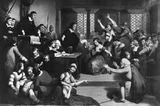
Presents a history in the form of a timeline of the persecution of witches prior to the Salem witch trials.
- Subject:
- Social Studies
- Material Type:
- Reading
- Provider:
- University of Missouri - Kansas City
- Date Added:
- 10/03/2023

Presents a history in the form of a timeline of the persecution of witches prior to the Salem witch trials.

A reproduction of the original warrant for the arrest of Elizabeth Proctor and Sarah Cloyce is shown together with a facing transcription.

This site provides a detailed chronology of the events related to the Salem Witch Trials, beginning with the settling of Salem (1629) and the adoption of the English law (1641) making witchcraft a capital crime. It covers all the major names, dates, and events that resulted in the trials and subsequent executions.

This is a transcript of the court examination of Bridget Bishop, April 19, 1692.

This is the original transcript of the trial examination of Mary Easty, accused witch, April 22, 1692.

This is a transcript of the court examination of Rebecca Nurse, March 24, 1692, with original spellings and syntax.

This court examination of Sarah Good, March 1, 1692, retains the original spellings and syntax. The accused is questioned for contact with the devil and harming children.

This is a court transcript of the examination of "Tituba the Indian Woman," on March 1, 1692, suspected of harming her children under the direction of demonic familiars. Transcript is unedited and features 17th century spellings and syntax.

This transcript of two letters written by Governor William Phips to the Earl of Nottingham, London, explains the presence of witchcraft in Salem and its environs and the Governor's response to the situation.

The text of these petitions, filed by Isaac Easty and William Good in 1710, request compensation for the prosecution of family members for witchcraft. Also included is Governor Dudley's order for payment of damages.

This webpage features the full text of the petitions for mercy made by Mary Easty and John Proctor, two convicted witches awaiting execution.

This is a selection of records of the trial and execution of Sarah Good that includes the summary of evidence, Sarah Good's confession, indictments against Sarah Good, and sentencing.

This webpage features a transcript of court testimony from the trial of Rebecca Nurse, with evidence for Nurse, evidence against Nurse, petition of Nurse, and juror's statement. Includes historic painting of a scene from the trial.

Focuses on this event's legal proceedings and includes the texts to original documents such as examinations, petitions and death warrants. Also contains brief biographical sketches of some of the people named as witches.

A concise yet detailed historical note about the Salem Witch Trials of 1692, its participants, and background. Discusses the legal proceedings and explains changes which have occurred in the American justice system since then, with respect to the definition of acceptable evidence.

This Hyperdoc asks students to read background and primary source material from the Salem Witch Trials and the McCarthy Trials in order to understand a primary theme from the play The Crucible by Arthur Miller. The Hyperdoc asks students to consider the way that fear impacts people by presenting opportunties for students to consider fear in their personal lives, in history, and in current events.

This Washington State University site provides a wonderful source for all the literary movements that have taken place in American Literature from 1620-1920. Click on the movement (listed on the left)you are interested in (Naturalism, Realism, Transcendentalism, etc.) and information will be provided on the definition, characteristics, practitioners, and context and controversy of each movement.